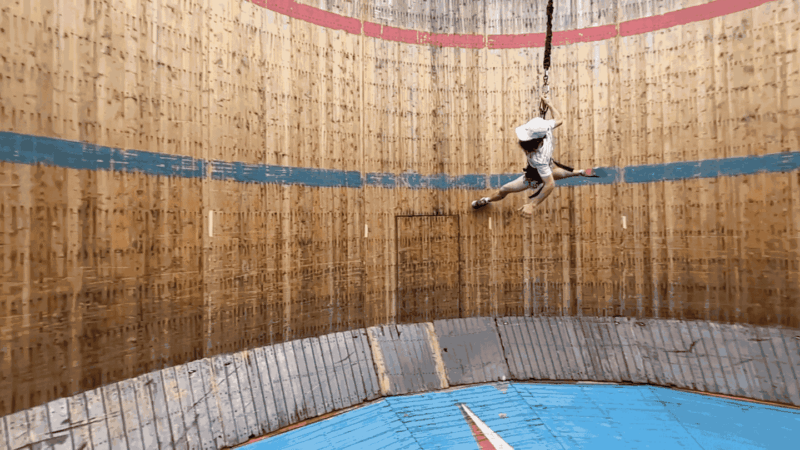It was a drizzly day, last year, when two researchers first took on the Wall of Death. This amusement park attraction near Parma, Italy, looks something like a giant wooden barrel with the top sawed off. But on this dreary day, exercise physiologists had commandeered the Wall for science. They would test its potential as a new way to exercise — on the moon!
Normally, daredevils on motorcycles zip along the circular Wall of Death’s interior sides. It’s a feat that seems to defy gravity. But Gaspare Pavei and Valentina Natalucci weren’t going to attempt motorcycle stunts. Indeed, there were no motor bikes. They’d be running on foot sideways, mid-way up the wall.
And, says Alberto Minetti, if they calculated things right, it would show future moon dwellers how to speed along the wall without tumbling to the ground.
Explainer: Gravity and microgravity
Why bother? A physiologist, Minetti works at the University of Milan in Italy. His team was exploring how they might give lunar inhabitants a way to keep their bodies strong.
And because the moon has only about a sixth of Earth’s gravity, it won’t be easy. That lower gravity means our bodies won’t feel the same stresses that they would while moving on Earth.
Pounding the pavement during a run or doing pushups against Earth gravity — referred to as 1 g — builds muscle and strengthens bone. But on the moon or in space, muscles weaken and bones become brittle. Just six months in space, researchers have shown, can damage the bones as much as a decade of aging. Scientists are looking for ways to avoid this, Minetti explains.
Running horizontally along a cylinder’s curved wall generates uniform circular motion, or the so-called centrifugal force. It’s the same thing that holds water at the bottom of a bucket when whirled overhead. Enough force would keep moon runners — and scientists mimicking lunar gravity in Italy — on the wall. They’d also experience a force that would closely mimic the gravity they normally feel on Earth.
Is centrifugal force “real”? Watch this video explain why it’s a “fictitious” or pseudo force, one suggested that seems true based on someone’s frame of reference.
Like the bikes
So on that gray day last June, Pavei and Natalucci from Minetti’s lab took a giant leap for science.
Each donned a harness attached to a bungee cord. That cord, in turn, hung down from a crane that was nearly 40 meters (130 feet) tall. This elastic suspension effectively reduced Pavei’s and Natalucci’s weight, mimicking moon gravity.
Then, the scientists had to figure out how to shift from standing on the ground to running sideways along the cylinder’s walls.
Pavei was up first. He sprinted straight at the wall like a kid trying parkour.
No luck.
He gently skidded down to the ground on his bungee cord. After a few more failed attempts, Pavei took a cue from Wall of Death motorcyclists. He approached the wall at an angle. He ran counterclockwise up a small ramp at the cylinder’s base in a spiraling path. Suddenly, Pavei was cruising around nearly horizontal. His shoes slapped the walls. His body was nearly parallel to the ground.
“WOW!” Minetti remembers screaming in excitement as he watched from the ground. “I knew that physics and mathematics predicted this,” he says, “but it’s different … when you see it in reality.”
The horizontal advantage
Minetti had worked for almost two years to get to this point. He had worked out the crane’s rental and how to take advantage of down time at the Wall of Death. He also had to convince his university to agree to the experiment. It was “not a very orthodox kind of request,” he says.
During repeat runs by Pavei and Natalucci, the team collected data. These included how far they’d traveled, how long their feet made contact with the wall and how long they were airborne between steps.
These data let them calculate the runners’ velocity and estimate just how much force had been generated during their sprints. It came to up to about three-quarters of a g, the scientists now report in the May Royal Society Open Science.
If moon colonists ran eight to nine laps in such a structure per day, the team calculates, that should be enough to avoid bone loss — even if they stopped to take breaks every few laps. They based that conclusion on data from prior work that tracked people’s bone density after bedrest and exercise.
Minetti’s team had just one day to run these experiments at the Wall of Death. Now he has follow-up questions, such as whether wall running could directly counteract the effects of bedrest experiments. Scientists sometimes use those tests to mimic the effects of low gravity on otherwise healthy people.
The University of Milan also has plans to build its own wall — the Moon Wall or M-Wall. It will be tailor-made for the team’s lab tests.
Minetti points out a minor issue for any would-be moon runners: a need for speed. To make this work, you have to race pretty fast, he says. We’re talking 5 to 6 meters per second — equivalent to running a roughly 5-minute mile.
You don’t need to be an elite athlete to sprint this fast, Pavei says. It’s roughly half as fast as the 100-meter dash world-record holder, Olympian Usain Bolt. But sprinting faster than the test runs would create more artificial gravity. And that would offer greater benefits for the body. If Bolt, for instance, were to sprint around the wall at top speed, he’d probably have no trouble surpassing 1 g, Pavei says.
To confirm that, he adds, “I would be very happy to test him.”




